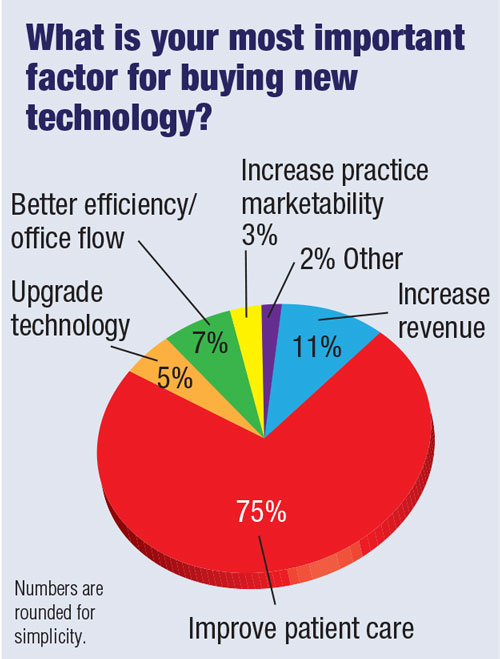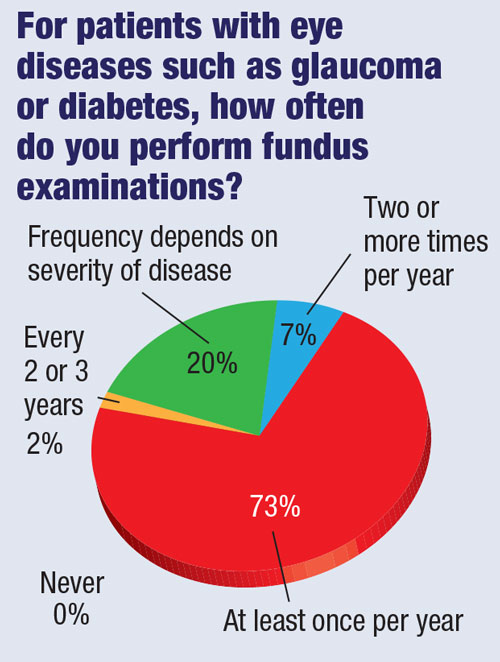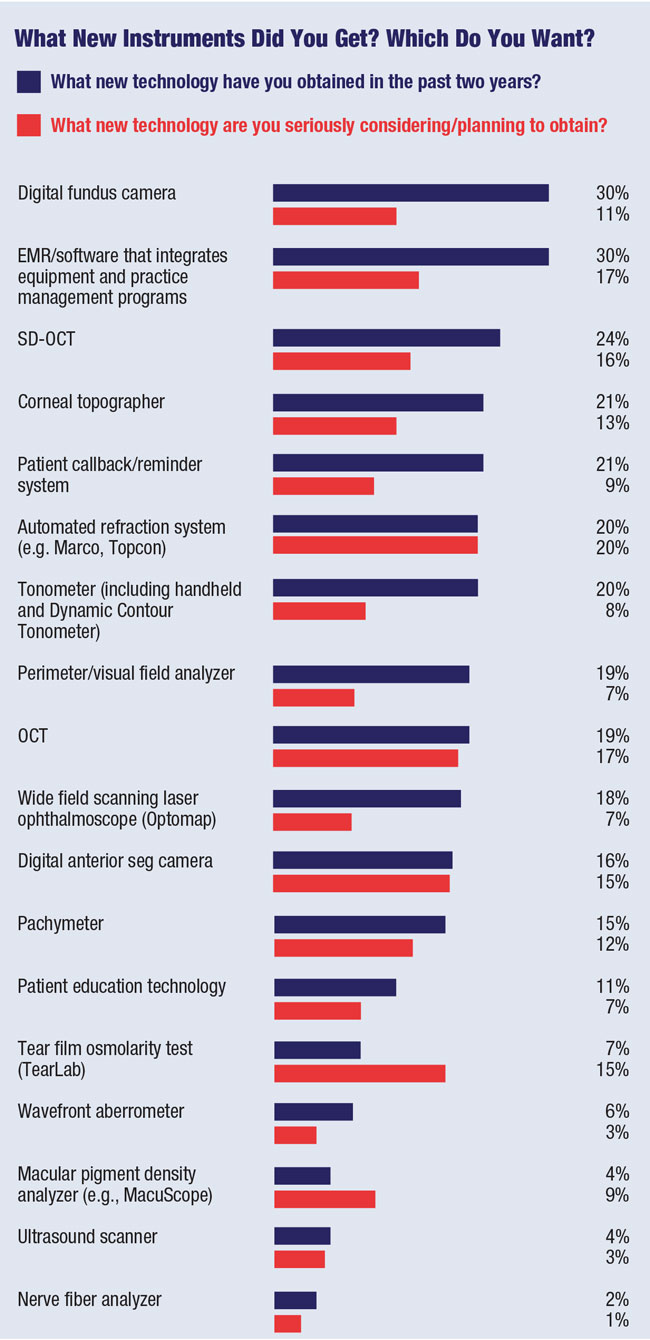What technology tops optometrists’ wish lists right now? You might be surprised to learn that it’s not a digital fundus camera or an optical coherence tomographer (OCT). It’s not even a whiz-bang instrument like a tear film osmolarity tester.
 |
The number one item that ODs are looking to buy: an automated phoropter.
“The automated refraction system I bought last year increased my efficiency, reduced chair time and is a huge ‘WOW’ with my patients,” says Mitchell Shulkin, OD, of San Diego. “I see more patients in less time.”
Optometrists like Dr. Shulkin and others are seeking to increase productivity by seeing more patients per hour. Of course, increasing efficiency doesn’t have to mean compromising care. Indeed, the primary reason why most ODs (75%) invest in new technology is to improve patient care.
These are just a few of the results from our latest Annual Diagnostic Technology Survey, based on the responses of 263 optometrists to an email questionnaire.
Top 10 Most Wanted
An automated phoropter is just one of the many technologies that optometrists currently have their eyes on. Of the top 10, here are the remaining nine most wanted items, in descending order:
2. OCT
3. Electronic health records (EHR)/software that integrates equipment and practice management programs
4. Spectral-domain OCT (SD-OCT)
5. Digital anterior segment camera
6. Tear film osmolarity test (TearLab)
7. Corneal topographer
8. Pachymeter
9. Digital fundus camera
10. Patient callback/reminder system
To obtain any of these instruments, optometrists aren’t planning to bet the farm. Most of the ODs surveyed (about 53%) said they’re planning to spend no more than $20,000 on new technology in the coming year. And of these, about two-thirds say they’ll spend less than $10,000.
The majority (72%) say they’ll buy their next big equipment investment, although one in four (24%) plan to lease it.
 |
 |
 |
Top 10 Recently Purchased
Here are the top technologies and instruments that optometrists obtained in the past two years, in descending order:
1 and 2 (tie). Digital fundus camera; EHR/software that integrates equipment and practice management programs
3. SD-OCT
4 and 5 (tie). Corneal topographer; patient callback/reminder system
6. Automated refraction system
7. Tonometer
8. Perimeter/visual field analyzer
9. OCT
10. Widefield scanning laser ophthalmoscope (Optomap)
Of these, it’s no surprise that EHRs topped the list, thanks to the Health Information Technology for Economic and Clinical Health (HITECH) Act, which essentially mandates EHRs by 2015.
For many ODs, the switch to EHR has actually done what it’s supposed to do: “Our new practice management software with EHR makes all aspects of the practice run better,” says optometrist Lee D. Caplan of Baltimore. “Eliminating [both] patient paper files and the problem with paper file storage is absolutely fantastic.”
 |
Other top technologies that ODs are happy with:
• Retinal camera. “We are a new office, and being able to offer the latest and greatest while still being affordable and profitable is great. And it’s great for when fill-in doctors and I see each other’s patients,” says Judy Nguyen, OD, of Newark, Calif. “A picture is worth a thousand words.”
Optometrist Leslie Varkey of Houston says, “I bought a fundus camera to better serve my patients. I take pictures of everything. It’s a great educational tool as well as great for documentation purposes. It has definitely increased my profit/revenue in the office.”
• OCT and SD-OCT. “The OCT has had a phenomenal effect on patient care. My geriatric population benefits because many have mobility issues and no longer need to travel to another office to have this test completed,” says Karyn R. Iovinelli, OD, of the Armed Forces Retirement Home Eye Clinic in Washington DC. “In addition to monitoring disease, I use this technology on all new patients to establish a baseline, which is stored in the database of the instrument.”
SD-OCT has “dramatically increased my ability to diagnose and manage retinal disease and glaucoma,” says Craig Match, OD, of Halifax, Pa. “Just today, in my small rural practice, I scanned two ERM patients with reduced vision, a Plaquenil check and a glaucoma six-month follow-up. Not all days are that busy with retinal disease, but it is nice to have the technology in house.”
• Widefield scanning laser ophthalmoscope. “We purchased an Optos Daytona widefield scanning camera for improved patient care. The longer we use it and trust the results, the more we incorporate it into our practice,” says Frank Chinisci, OD, of Albuquerque, NM. “It helped reduce exam time and patient waiting time, and it increased patient education, the thoroughness of my exams and our profits.”
While three out of four optometrists say they obtained their new equipment to improve patient care, about the same number of ODs (73%) report that their recent investment also increased their profitability. So, good care makes good sense.
|
ODs’ Other Favorite Technologies
• Macular pigment optical density (MPOD) testing. “The densitometer has helped to find those patients at higher risk for AMD and measure improvements in MPOD after supplemental therapy. This helps to differentiate my practice, as no one else in the area offers this service. It is also a boost to our bottom line, as the sale of carotenoid supplementation in office has become a profit center.”—Alan Bishop, OD, Easton, Md. • Multi-spectral imaging (MSI) digital ophthalmoscope. “New MSI equipment [Annidis RHA] is letting us find early macular RPE [retinal pigment epithelium] changes in some people very early in the process. This week, I had a 28-year-old with visible changes and counseled her on smoking cessation and carotenoid supplement use. Patient care has been enhanced.”—Christopher Olson, OD, Mount Pleasant, Iowa. • OCT/fundus camera. “Last year, I purchased a Cirrus photo 600 OCT/fundus autofluorescence camera (Carl Zeiss Meditec) and a corneal pachymeter. I purchased these because I wanted to expand my scope of practice and take care of my patients. I was tired of referring patients out to other doctors to manage these patients only because I did not have the proper diagnostic equipment. Not only have these purchases allowed me to do that, but they have significantly increased my practice revenue. I’m taking better care of my patients than ever before.”—Sara Kurtis, OD, Moline, Ill. and Davenport, Iowa. • Pattern electroretinography testing. “The Diopsys [NOVA-ERG] electrodiagnostic (ED) system allows us to monitor functionality of the visual electrical pathways, as opposed to direct viewing or imaging. ED testing adds to our management of glaucoma, macular degeneration and diabetes, as well as possibilities with traumatic brain injury, amblyopia and learning disorders. Patients are impressed by the technology and testing is reimbursed well by insurance.”—Rodney Fong, OD, Honolulu, Hi. |

